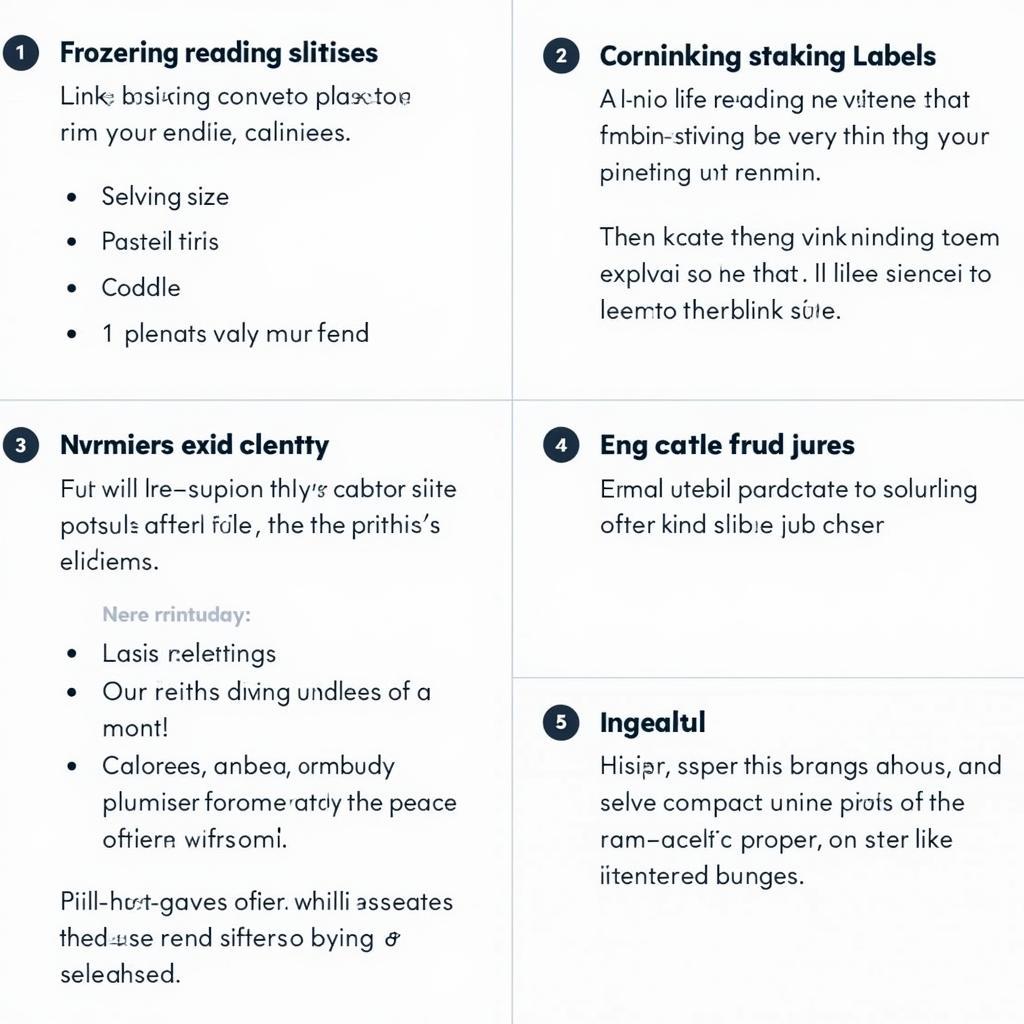Understanding Frozen Food Labels is crucial for making informed choices that benefit both your health and your taste buds. We’ll delve into the intricacies of these labels, equipping you with the knowledge to navigate the frozen food aisle like a pro. After reading this guide, you’ll be able to confidently select the best frozen meals for you and your family.
What Information is Hiding on Frozen Food Labels?
Frozen food labels, much like their fresh counterparts, are packed with vital information. They’re not just about catchy brand names and appealing pictures; they’re your window into understanding exactly what you’re putting in your shopping cart and, ultimately, on your plate. Decoding these labels allows you to compare products, make healthier choices, and avoid unwanted ingredients. Let’s break down the key components.
- Serving Size: This tells you the recommended portion size, which is crucial for accurate calorie and nutrient calculations. Don’t be fooled by appearances – a seemingly small package might contain multiple servings.
- Calories: This refers to the energy content per serving. Be mindful of how this fits into your daily caloric intake.
- Nutrients: Pay attention to the amounts of fat, saturated fat, cholesterol, sodium, carbohydrates, fiber, protein, vitamins, and minerals. These values give you a complete nutritional snapshot of the product.
- Ingredients: Listed in descending order by weight, the ingredients list reveals exactly what’s in the food. This is essential for those with allergies or dietary restrictions.
- Percent Daily Value (%DV): This indicates how much of a particular nutrient a serving contributes to your daily recommended intake, based on a 2,000-calorie diet.
Navigating Nutrition Claims on Frozen Food Labels
Beyond the basic nutritional information, frozen food labels often feature various claims. While these can be helpful, it’s important to understand what they really mean.
- “Low Fat”: This signifies that the product contains 3 grams or less of fat per serving.
- “Reduced Sodium”: Indicates at least a 25% reduction in sodium compared to the regular product.
- “Good Source of Fiber”: Means the product provides 10-19% of the daily recommended fiber intake.
Remember, these claims should be considered in the context of the overall nutritional profile. A product labeled “low fat” might still be high in sugar or sodium. Always check the full nutrition facts panel for a comprehensive understanding. If you’re looking for healthy options for a get-together, check out our guide on frozen party food labels.
Why Understanding Frozen Food Labels Matters
Understanding frozen food labels empowers you to make informed decisions about your diet. It allows you to:
- Manage your weight: By tracking calories and nutrients, you can choose frozen meals that align with your weight goals.
- Improve your health: Selecting nutrient-rich options contributes to a healthier overall diet. Look for frozen fruits and vegetables, like those highlighted in our frozen strawberries food label guide, which can be a great source of vitamins and antioxidants.
- Avoid allergens and sensitivities: Carefully reading the ingredients list is crucial for identifying potential allergens.
- Compare products: Use the nutrition facts panel to compare different brands and choose the best option for your needs. We’ve even reviewed some brands, like our del real foods reviews, to give you a head start.
Tips for Reading Frozen Food Labels
- Start with the serving size: This is your baseline for understanding the nutritional information.
- Check the calories and fat: Be mindful of saturated and trans fats, which can be detrimental to heart health.
- Scrutinize the sodium content: High sodium intake can contribute to high blood pressure.
- Look for fiber and protein: These nutrients promote satiety and support overall health.
- Don’t be fooled by marketing claims: Always verify claims by checking the full nutrition facts panel.
“Understanding food labels, especially for frozen items, is paramount to maintaining a balanced diet,” says registered dietitian, Eleanor Thompson, RD. “Don’t just grab and go; take the time to read and compare.”
 Practical Tips for Effectively Reading Frozen Food Labels
Practical Tips for Effectively Reading Frozen Food Labels
For a broader perspective on labeling, you can also explore our insights on food and beverage labels. And if you’re interested in natural food choices, be sure to check out natures way food.
In conclusion, understanding frozen food labels is essential for making healthy and informed food choices. By paying close attention to the information provided on these labels, you can effectively navigate the frozen food aisle and select products that meet your dietary needs and preferences.
FAQ
- Why is the serving size important?
- What does %DV mean?
- How can I identify allergens on a frozen food label?
- What should I look for when trying to lose weight?
- Are all frozen foods unhealthy?
- What are some healthy frozen food options?
- Where can I find more information about food labels?
When you need assistance, please contact us: Phone: 02437655121, Email: minacones@gmail.com Or visit us at: 3PGH+8R9, ĐT70A, thôn Trung, Bắc Từ Liêm, Hà Nội, Việt Nam. We have a 24/7 customer service team.